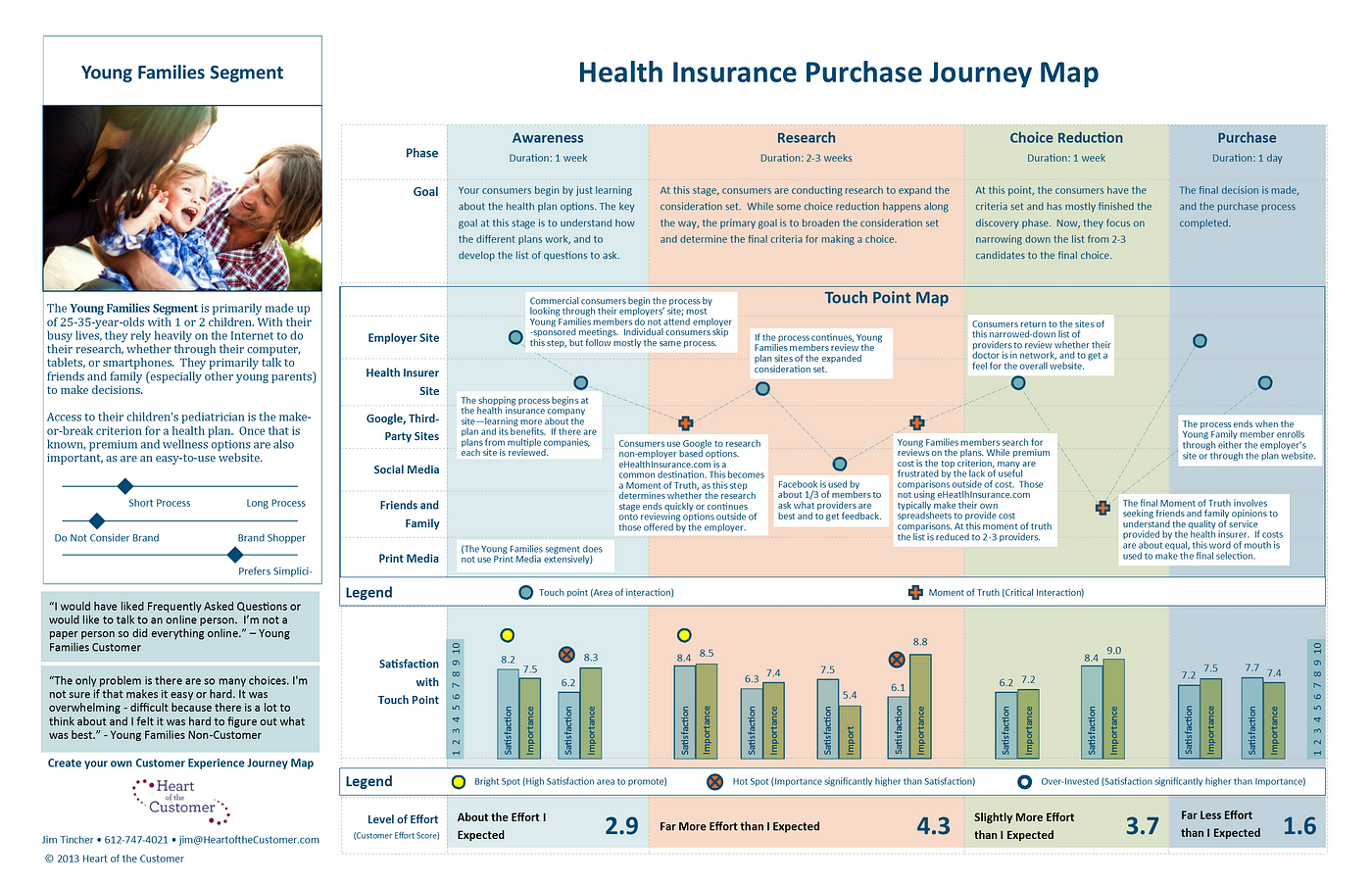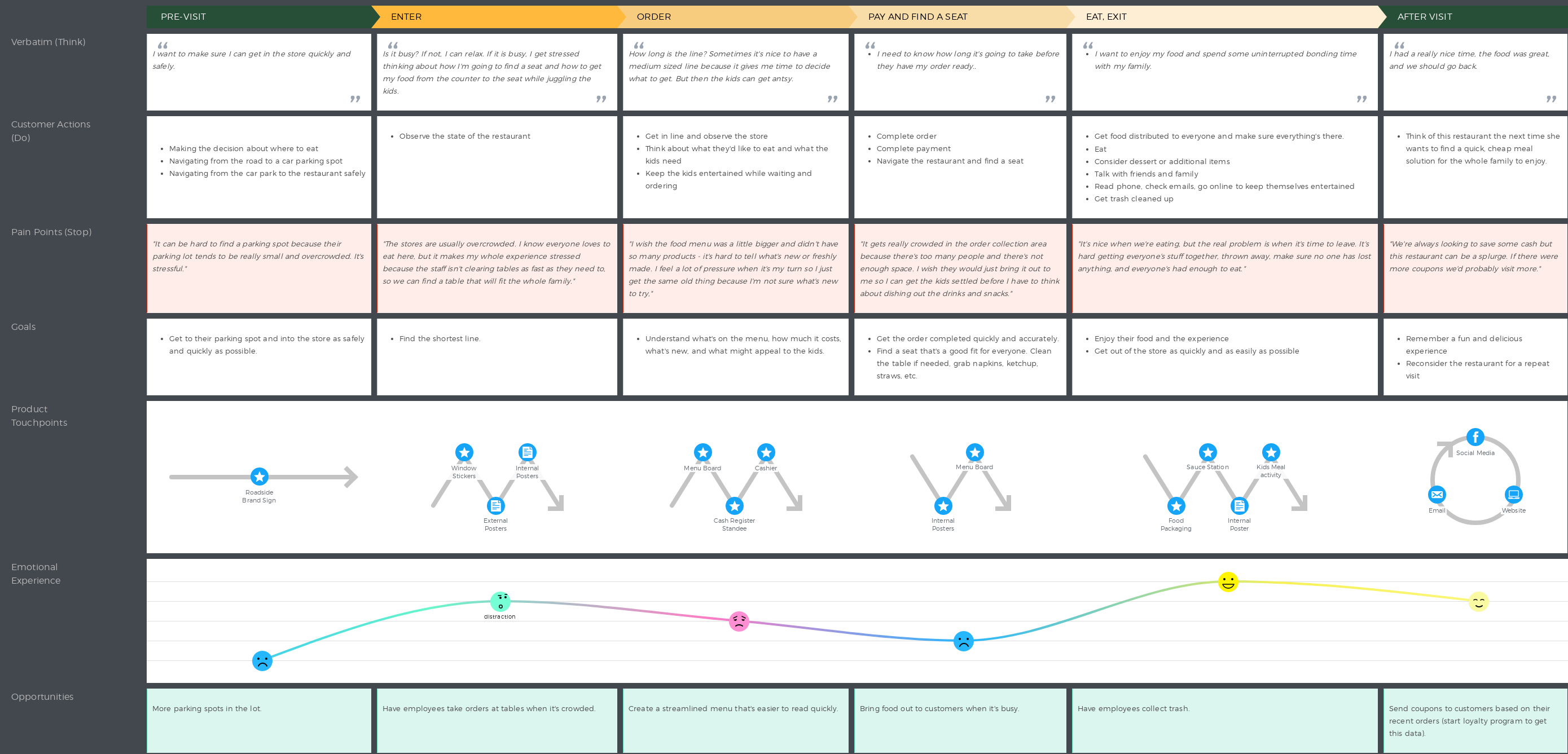Get to the heart of your customer’s world with this valuable tool
The process of [customer journey] mapping uncovers the key customer moments that, once improved, will unlock a more compelling and more valuable overall experience.- Adaptive Path, “Guide to Experience Mapping”

Customer journey maps are a visual story about how people interact with your brand. They help brands gain a deep understanding of their customers and act as a bridge between business and buyer.
In a single illustration, the journey map aims to capture the entire customer experience.
No small task.
Done well, they empower people to work cross-functionally and iron out all of your customer experience issues. They serve as long-term assets that can guide your brand for the next 2–3 years.
Done poorly, journey maps can confuse, misalign, and are cast aside.
What’s a customer journey map supposed to look like?

If you type “customer journey map” into an image search, you’re likely to be more confused than enlightened.
Experience Mapping has its roots in design, but since its adoption into the business mainstream, interest has exploded.
The result is hundreds of boutique CX agencies putting their proprietary spin on the basic template.
Instead of trying to cover every type of customer journey map here, I’ve distilled them into essential elements in the template below.

With a strong understanding of the fundamentals, you can iterate to your heart’s content. But for now, this template collates a few must-haves.

The six must-have parts of a customer journey map
As with many frameworks, there isn’t a one-size-fits-all template. The specific sections and wording will be different from brand to brand.
But no matter their ultimate end-design, all share the same goal and a few essential elements. If your journey Map includes the following you’re on the right track:
- A customer persona
A marketing persona is a semi-fictional representation of a group of your customers. Based on research and data from your existing customers, a persona is a heuristic that represents an essential segment of your buyers.
Personas bring your customers to life through both demographic and psychographic details.

Based on research and data from your existing customers, a persona is a heuristic that represents an essential segment of your buyers.
Limit journey maps to the experience of one persona and their path toward one primary goal. If you try to capture every single customer and every journey they take in one map, you’ll miss the signal in the noise.
Limit journey maps to the experience of one persona and their path toward one primary goal.
2. Phases of the Purchase Journey
This section details the process customers follow from awareness, to purchase, and beyond. In real life, this isn’t a straight line, and different parts might overlap. But for the sake of illustration, we divide the journey into discrete steps.
In consumer brands, there are usually 4–6 phases in a purchase journey. When you design your map, you may include more, less, or different steps. It all depends on your particular industry, product, and customer type.
A B2B software procurement journey will look very different from someone thinking about where to eat lunch.
So while the framework is a secure starting place, your purchase journey will likely look different than this basic template.

These are the general phases of a B2C consumer journey, but these will vary depending on your specific brand, sales channels, and industry.
3. Touchpoints
A point of contact, interaction, or information gathering. Touchpoints can be owned by the brand (such as a TV ad or website), or reflect the brand experience in some way (such as Social Media or Amazon reviews).
Be sure to denote touchpoints used during Moments of Truth (see point #8 below) in your journey map.

4. Customer Thoughts and Actions (Verbatim)
Capturing the combination of what customers do, think, and feel is why journey maps are so useful. Customer verbatim (quotes) help us understand customers’ perceptions. It also gives us a steer on where we should start improving the experience.
Verbatim paint a more vivid and compelling picture of your customers and their experiences.

5. Pain Points (what’s stopping our customers)
Here we capture the most significant issues that customers have when pursuing their mission.
Each pain point will be bucketed into a part of the Purchase Journey. We’ll then associate it with a touchpoint or lack thereof.
While performing qualitative research, you’ll find that customers are honest about their complaints.
The challenge will be using data and further analysis to decide which of these to include.

6. The customer’s emotional journey
This is the secret sauce that makes customer journey maps, especially helpful. By understanding the peaks and valleys in your customer’s emotional journey, you’ll identify those areas for improvement.

7. Opportunities for Improvement
This section is where you can build on the pain points, emotional journey, and customer feedback to start painting a picture of the future.
Often these areas act as thought starters for more robust research projects or CX initiatives.

8. Moments of Truth
These are the moments your brand has the biggest opportunity to influence customer decision, opinion, and action.
MOT typically occur when the customer first encounters your product, when they purchase your product, use it, and then react to how it works.

5 guiding principals for creating your journey map
Customer journey maps may vary in specific sections and design, but they all share several guiding principals:
- They’re written from the customer’s point of view, not the company’s. The purpose of the journey map is to close the Empathy Gap between marketer and consumer. This can be tricky to do from inside an organization. That’s why I recommend brands hire an agency to build their journey maps, to get the benefit of an outsider’s view.
- They combine the mechanics of experience with the customer’s emotional response. Here’s where the magic happens. The magic of journey maps doesn’t come from documenting a customer’s experience. Instead, it’s from combining the mechanics of experience with the emotions and perceptions of a customer. One without the other is a story without substance (or vice versa).
- They document the customer’s omnichannel journey. Journey maps capture how people use multiple touchpoints. From a customer’s view, every interaction is part of one significant experience. There’s no online or offline, above-the-line or below it. It’s only one company, one product, and one experience to them.
- They are visualization tools. The challenge of managing the customer journey is vast, but the upside is significant too. To get buy-in for CX initiatives, you’ll need everyone on the same page regarding pain points, challenges, and opportunities. The visual nature of the CJM has two benefits. One, everyone gets closer to understanding the complexities of your customer experience. Two, you can use it as a socialization tool to gain alignment and buy-in from internal partners.
- They define and capture the phases of the customer purchase journey. Ultimately, customer experience initiatives need to drive ROI. By aligning the journey map to a customer path with a measurable goal, you can keep everyone focused. Without this aim, it’s easy to get lost in tactical initiatives that drive short-term action, but no long-term gains.

A checklist for your finished journey map
Once you’ve got the parts assembled and a hypothesis map created, use this checklist to make sure your map hits all the right notes:
- Does your customer journey map focus on just one persona?
- Does it follow the purchase/interaction journey across all sales channels?
- Does your customer journey map include both mechanical and emotional customer measures (thoughts, feelings, pain points, emotional responses, etc.)?
- Did you include Moments of Truth in your map?
- Does it contain opportunities for innovation, based off of the pain points and Moments of Truth you identified?
- Including the elements above will ensure that your customer journey map is customer-centric, insightful, and useful to your organization.
The bottom line
Creating a customer journey map is not a small project. It requires lots of time, effort, and coordination across teams.












